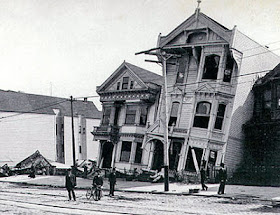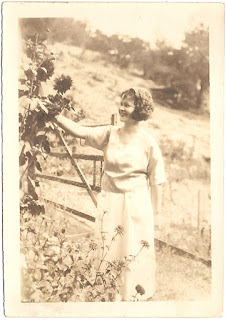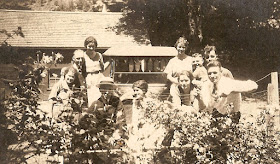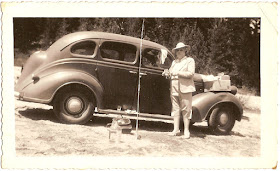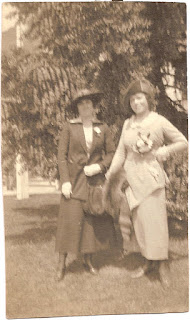Poking around in old newspapers, census records, and online
indexes, I’m trying to pick up on a part of the Bean family history that I had
never heard mentioned before. The fact that
Leon S. Bean, the
successful Palo Alto builder, had not only stepped past the late stages of the prim and proper Victorian
era to be
involved in a divorce, but then to remarry, was something never
mentioned among the Bean family members that I knew personally.
I wanted to find out something more about just who this
woman was that Leon
married. Who was Emma Bement? That was the name listed in the San Jose newspaper that carried the marriage
announcement. And yet, I couldn’t find any further—or even previous—mention of
that name.
Though joining those symbiotic genealogy partners,
Ancestry.com and
FamilySearch.org, I couldn’t come up with any results—not even
a death record online for her as Emma Bean.
As is often the case, it took a lot of bouncing around
between several online resources—testing all the possibilities, tracing them
back several decades to insure the right information was captured—before I
could feel secure in what I discovered.
At least I had “Square One” to start from. The marriage
announcement did include ages, which helped—microscopically.
As for Emma’s “maiden” name—Bement—it turned out to be a
false lead. Emma had evidently been married before. But at this point, how was
I to know?
So the fifty-seven year old Leon takes a second wife. She, at
that point is fifty, herself. Not exactly what one would call a trophy wife,
but who’s counting? Leon
barely outlives the wedding…well, I exaggerate…passing on a mere eight years
later.
What, then, becomes of Emma and the “considerable fortune” Leon has
amassed?
The clumsiness with which both Ancestry.com and
FamilySearch.org stumble over common names such as Emma Bean did not help
matters. I followed up with searches in the various databases for Emma Bement,
her former name, with no success either. It took going back a
second time to the
San Mateo County Genealogical Society website before I found some hints.
My first possibility was that Emma Bean had remained in Palo Alto or Redwood
City. The
1930 census did show a widowed Emma Bean with
her sister, Clemma Epperley, at 537
Addison Street.
Because I had not been able to find any death information
for Emma Bean, I thought perhaps the surname Bement was what was preventing
productive search results. Next step: use Emma’s sister, Clemma, to discover
what their maiden name might be.
While a first name like Clemma might cause one to anticipate
gleaning from search results might be akin to cherry picking, let me disabuse
you of that notion. Clemma, herself, evidently was married more than once.
Thanks to various local indexes on the website for the San Mateo County
Genealogical Society, I did piece together the story for Clemma: married to an
Epperley—no, here’s a different record, so make that an Epperly—she was
previously known as Mrs. Tully, wife of Frank.
But no maiden name.
It took a lot of dodging in and out of databases and online
resources to find the one listing—by now, I’ve forgotten for which of the
sisters it was—that showed the maiden name to be Green.
Oh, great: Green. Nothing like making the search easier!
Thankfully, somewhere along the line, I did find a listing
suggesting that their father’s name was Leo. Checking an
1880 census record
from Watsonville in Santa
Cruz County—a little
off course, admittedly, for the Santa Clara
sisters in Palo Alto—I
was able to determine that this was a solid possibility. Well, solid, that is,
as long as the name Clemma is not that common a name. The 1880 family grouping
did, however, coincidentally include sisters Clemma and Emma.
I couldn’t find any death records, though, for either Clemma
or Emma—and that’s why I had pursued
that maiden name. I wanted to move from date of death to find an obituary.
It was, once again, thanks to a small, local database, that
I found Emma’s date—ironically, the small and agile once again trumps the
genealogy powerhouses. From there—that tiny local website database—I moved back
to Ancestry.com, holding my breath all along in hopes that their newspaper
collection would include the dates that might hold Emma’s obituary. So often,
those gaps in the collection seem to be strategically placed to obliterate all
my hopes.
There, however, in the San
Mateo Times—and
not even missing out on the obligatory journalistic errors—was a remembrance of
the former city resident.
Redwood
City--Mrs. Emma Bean, 93,
a former long-time resident of Redwood City,
died yesterday at a Santa Clara
county hospital. A native of Watsonville, Mrs.
Bean resided in Redwood City for 35 years before
she and her husband, the late Leon Bean, moved to Palo Alto in 1946 to make their home at 537 Addison avenue.
Surviving are a sister, Mrs. William Jefford, and a niece, Mrs. Alma Smith, both of Salinas.
Funeral services will be held at 11 a.m. Friday from Crippen and Flynn chapel. Entombment will be in Alta Mesa Memorial park, Los Altos.
It was such a small mention. Same old address, though. But
with a strange twist. Unless I can chalk this up to yet another newspaper
error, Emma was not even buried in the same cemetery as her husband. Let me
amend that even further: not buried, entombed.
Almost makes me want to go look up a couple wills.
